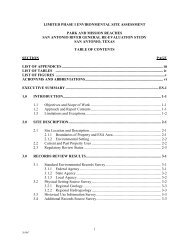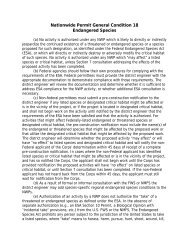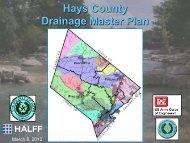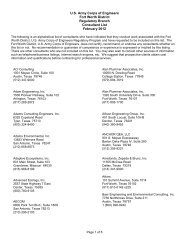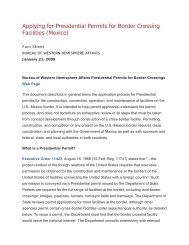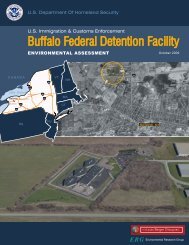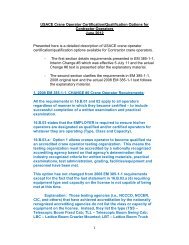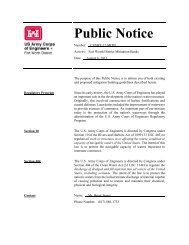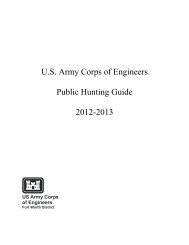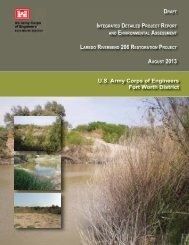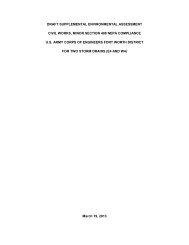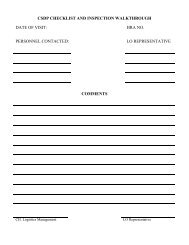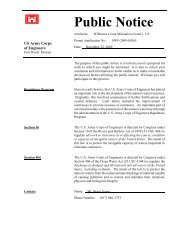3-351PollutantTable 3-4. National Ambient Air Quality StandardsPrimary StandardsSecondary StandardsLevel Averaging Time Level Averaging Times2345678910111213141516171819202122232425262728CO9 ppm (10 mg/m 3 ) 8-hour (1) None35 ppm (40 mg/m 3 ) 1-hour (1)0.15 μg/m 3 (2) Rolling 3-MonthPbAverageSame as Primary1.5 μg/m 3 Quarterly Average Same as Primary53 ppb (3) AnnualNO 2 (Arithmetic Average)Same as Primary100 ppb 1-hour (4) NonePM-10 150 μg/m 3 24-hour (5) Same as Primary15.0 μg/m 3 Annual (6)PM-2.5(Arithmetic Average)Same as Primary35 μg/m 3 24-hour (7) Same as Primary0.075 ppm(2008 std)8-hour (8)Same as PrimaryO 30.08 ppm(1997 std)8-hour (9)Same as Primary0.12 ppm 1-hour (10) Same as PrimaryAnnual0.03 ppm(Arithmetic Average)SO 20.14 ppm 24-hour (1)0.5 ppm 3-hour (1)75 ppb (11) 1-hour NoneSource: USEPA 2010a at http://www.epa.gov/air/criteria.htmlUnits of measure for the standards are parts per million (ppm) by volume, parts per billion (ppb - 1 part in 1,000,000,000) byvolume, milligrams per cubic meter of air (mg/m 3 ), and micrograms per cubic meter of air (μg/m 3 ).(1) Not to be exceeded more than once per year.(2) Final rule signed October 15, 2008.(3) The official level of the annual NO 2 standard is 0.053 ppm, equal to 53 ppb, which is shown here for the purpose of clearercomparison to the 1-hour standard(4) To attain this standard, the 3-year average of the 98th percentile of the daily maximum 1-hour average at each monitor withinan area m<strong>us</strong>t not exceed 100 ppb (effective January 22, 2010).(5) Not to be exceeded more than once per year on average over 3 years.(6) To attain this standard, the 3-year average of the weighted annual mean PM2.5 concentrations from single or multiplecommunity-oriented monitors m<strong>us</strong>t not exceed 15.0 μg/m3.(7) To attain this standard, the 3-year average of the 98th percentile of 24-hour concentrations at each population-oriented monitorwithin an area m<strong>us</strong>t not exceed 35 μg/m3 (effective December 17, 2006).(8) To attain this standard, the 3-year average of the fourth-highest daily maximum 8-hour average ozone concentrations measuredat each monitor within an area over each year m<strong>us</strong>t not exceed 0.075 ppm. (effective May 27, 2008)(9)(a) To attain this standard, the 3-year average of the fourth-highest daily maximum 8-hour average ozone concentrationsmeasured at each monitor within an area over each year m<strong>us</strong>t not exceed 0.08 ppm.(b) The 1997 standard—and the implementation rules for that standard—will remain in place for implementation purposes asUSEPA undertakes rulemaking to address the transition from the 1997 ozone standard to the 2008 ozone standard.(c) USEPA is in the process of reconsidering these standards (set in March 2008).(10) (a) USEPA revoked the 1-hour ozone standard in all areas, although some areas have continuing obligations under thatstandard ("anti-backsliding").(b) The standard is attained when the expected number of days per calendar year with maximum hourly averageconcentrations above 0.12 ppm is < 1.(11) (a) Final rule signed June 2, 2010. To attain this standard, the 3-year average of the 99th percentile of the daily maximum 1-hour average at each monitor within an area m<strong>us</strong>t not exceed 75 ppb.Douglas FOB EADraftAug<strong>us</strong>t 2011
3-361234567891011121314151617181920212223242526272829303132333435363738394041424344454647The AZDEQ has adopted USEPA’s NAAQS as Arizona’s criteria pollutants. Areas that fail tomeet Federal standards for ambient air quality are considered non-attainment. AZDEQ andUSEPA have classified Cochise County as in attainment for all NAAQS (USEPA 2010a).3.9.1.1 Greenho<strong>us</strong>e Gases and Climate ChangeGlobal climate change refers to a change in the average weather on the earth. Greenho<strong>us</strong>e Gases(GHGs) are gases that trap heat in the atmosphere. They include water vapor, carbon dioxide(CO 2 ), methane (CH 4 ), nitro<strong>us</strong> oxide (N 2 O), fluorinated gases including chlorofluorocarbons(CFC) and hydrochlorofluorocarbons (HFC), and halons, as well as ground-level O 3 (CaliforniaEnergy Commission 2007). The major GHG-producing <strong>sector</strong>s in society include transportation,utilities (e.g., coal and gas power plants), ind<strong>us</strong>try/manufacturing, agriculture, and residential.End-<strong>us</strong>e <strong>sector</strong> sources of GHG emissions include transportation (40.7 percent), electricitygeneration (22.2 percent), ind<strong>us</strong>try (20.5 percent), agriculture and forestry (8.3 percent), andother (8.3 percent) (California Energy Commission 2007). The main sources of increasedconcentrations of GHG due to human activity include the comb<strong>us</strong>tion of fossil fuels anddeforestation (CO 2 ), livestock and rice farming, land <strong>us</strong>e and wetland depletions, landfillemissions (CH 4 ), refrigeration system and fire suppression system <strong>us</strong>e and manufacturing (CFC),and agricultural activities, including the <strong>us</strong>e of fertilizers (California Energy Commission 2007).Final Mandatory GHG Inventory RuleIn response to the Consolidation Appropriations Act (Ho<strong>us</strong>e Resolution [H.R.] 2764; PublicLaw 110–161), USEPA has issued the Final Mandatory Reporting of Greenho<strong>us</strong>e Gases Rule.The rule requires large sources that emit 25,000 metric tons (27,557 United States tons) or moreper year of GHG emissions to report GHG emissions in the United States, collect accurate andtimely emissions data to inform future policy decisions, and submit annual GHG reports to theUSEPA. The final rule was signed by the Administrator on September 22, 2009, published onOctober 30, 2009, and made effective December 29, 2009.Executive Order 13514EO 13514, Federal Leadership in Environmental, Energy, and Economic Performance, signedon October 5, 2009, directs Federal agencies to reduce GHG emissions and address climatechange in NEPA analysis. It expands upon the energy reduction and <strong>environmental</strong> performancerequirements of EO 13423, Strengthening Federal Environmental, Energy, and TransportationManagement. It identifies numero<strong>us</strong> energy goals in several areas, including GHG management,management of s<strong>us</strong>tainable buildings and communities, and fleet and transportationmanagement.GHG Threshold of SignificanceThe CEQ provided draft guidelines for determining meaningful GHG decision-making analysis.The CEQ GHG guidance is currently undergoing public comment at this time; however, the draftguidance states that if the proposed action would be reasonably anticipated to ca<strong>us</strong>e directemissions of 25,000 metric tons (27,557 United States tons) or more of CO 2 GHG emissions onan annual basis, agencies should consider this an indicator that a quantitative and qualitative<strong>assessment</strong> may be meaningful to decisionmakers and the public. For long-term actions thathave annual direct emissions of less than 25,000 metric tons (27,557 United States tons) of CO 2 ,CEQ encourages Federal agencies to consider whether the action’s long-term emissions shouldreceive similar analysis. CEQ does not propose this as an indicator of a threshold of majorDouglas FOB EADraftAug<strong>us</strong>t 2011



